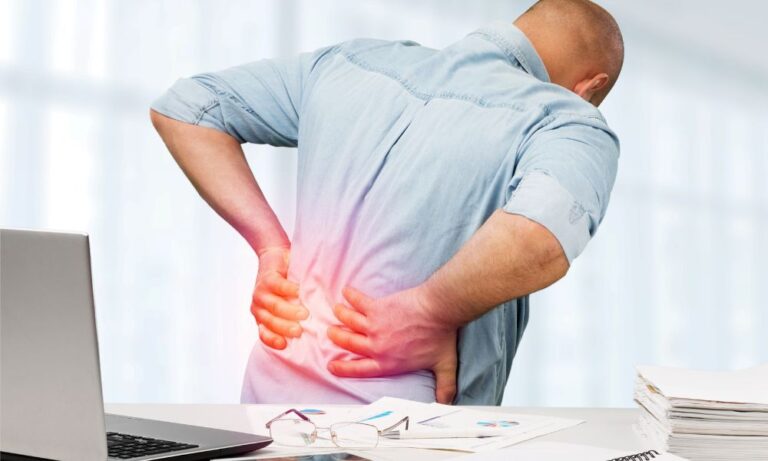Are you suffering from severe neck pain caused by cervical spinal stenosis? Don’t worry. There are some things you can do to reduce your pain.
Musculoskeletal health is essential for a quality of life. At the time of this writing, cervical spinal stenosis cannot be cured, only managed. But the management of the condition is essential to provide you with the highest quality of life possible. If you have cervical spinal stenosis, you should heed these warnings:
1. DON’T Perform Exercises That Roll Your Neck Around
There are a number of exercises you can safely do when you have cervical spinal stenosis. These include:
- Side to Side Strengthener
- Side Tilt
- Chin Tuck
- Shoulder Circles
But exercises that roll your neck around are not advised. Such exercises can exacerbate the problem and lead to greater pain and discomfort when you have cervical spinal stenosis.
2. DON’T Look Down At Your Phone Or Tablet For Long
When you look down you are increasing the strain on your neck. If you do so, for an extended period of time (>10 minutes), you increase the likelihood of pinching nerves and causing other difficulties with cervical spinal stenosis.
3. DON’T Cradle Your Phone Up To Your Ear
Cradling your phone up to your ear is another thing that can stress your cervical spinal stenosis. It’s an awkward position that strains the respective joints. Instead, you should use a speakerphone or a hands-free headset when you are having long phone conversations.
4. DON’T Carry a Heavy Pack On One Shoulder
If you carry a backpack make sure you carry it on both shoulders to properly spread the weight about. Over a long time, a backpack (or bag, or purse for that matter) depending on one shoulder will disrupt your walk and pull down on one side of your neck. This, too, can exacerbate cervical spinal stenosis.
5. DON’T Ignore Pain Or Stiffness In The Neck
Of course, you shouldn’t ignore pain or stiffness anywhere, as a general rule. But when you have cervical spinal stenosis, paying attention to the condition of your neck is particularly important. Pain or stiffness in the neck that worsens quickly or doesn’t resolve within two weeks requires some kind of medical appraisal. 
6. DON’T Drive If You Cannot Look Over Your Shoulder Properly
This is a no-brainer. Driving requires a fully functional neck. Even if you have a rear-view camera, those typically don’t flash on unless you are going in reverse. They will not help you change lanes safely. If your neck is causing problems in that regard then don’t drive.
7. DON’T Sleep On Your Stomach.
When you sleep on your stomach, you must, out of necessity, twist your neck to the side. This stresses the neck and will aggravate your cervical spinal stenosis. Furthermore, if you have something of a gut, that will apply pressure to your spine as well. Avoid both these things. Sleep either on your side or on your back.
8. DON’T Play High-Risk Sports
Avoid high-risk or high-impact sports like ice hockey, wrestling, football, skiing, diving, snowboarding, or rugby, if you have cervical spinal stenosis. These sports run a significant risk of inflicting injury upon you. Injuries to the neck are that much worse if spinal stenosis is present.
9. DON’T Delay Treatment
This is as true of cervical spinal stenosis as of any medical condition. Delaying treatment simply allows the problem to progress and get worse. Pain will increase and your options for treatment will diminish.
Scientific Studies on Cervical Spinal Stenosis
A January 2010 study found an increased chance of neurologic deterioration in the neck when there was a narrowing of the spinal canal like that found in spinal stenosis. The same study found that, when cervical spinal stenosis is present, even a minor injury of the neck can result in irreversible damage.
A case study provided by Science Direct reports on a 70-year-old teacher injured in a motor vehicle accident. Within several hours of the event, she was suffering from headaches, neck pains, and a burning sensation on the left half of her body.
Initially incorrectly diagnosed, the patient, after further examination and diagnosis, was determined to have deformation of the spinal cord as well as cervical spinal stenosis.
Treatment from a chiropractor using two different chiropractic techniques led to complete relief for the patient. A follow-up one year later found the patient to still be symptom-free.
What Can Happen If Cervical Spinal Stenosis Is Left Untreated?
Cervical spinal stenosis is a very serious condition that only gets worse as time goes by. It is best to begin treatment as soon as you are diagnosed. If left untreated, cervical spinal stenosis can cause permanent injury, paralysis, and even death.
Fortunately, although there is no known cure, there are ways to mitigate the progression of the disease. A common measure is a surgery. However, there are more conservative, non-invasive techniques that can also serve to alleviate the symptoms of this condition.
These range from simple medications to a chiropractic adjustment for cervical stenosis, to gentle stretches and exercises like yoga.
What Causes Cervical Spinal Stenosis?
Cervical spinal stenosis can be caused by the misalignment of the neck or spine. Specifically, it usually is a direct result of the subluxation of the c1 and c2 vertebrae. This can be caused by poor posture or simply the wear and tear that comes with aging. Some kinds of injuries as well as the growth of tumors can also cause or worsen this condition.
What Are the Symptoms of Cervical Spinal Stenosis?
The most obvious symptom of cervical spinal stenosis is neck pain. Many doctors will advise you to avoid all activities that make such pain worse. They may suggest you avoid walking uphill, riding bicycles, or other such things.
Many chiropractors, however, will often suggest you try to remain as active as possible. Their reasoning is that, although inactivity will hurt less, it will, over time, lead to muscular deterioration around the neck.
They suggest you continue normal activities to keep the muscles strong. Here are a number of tips to get rid of neck pain you can use. Also, be aware, that there are other symptoms besides neck pain:
- Numbness and/or tingling in an arm, hand, foot, or leg
- Balance difficulties
- Problems walking (often due to balance issues)
- Problems with bladder control
Once cervical spinal stenosis is positively diagnosed, chiropractors can implement a treatment routine to help alleviate its symptoms. This will likely begin with a chiropractic adjustment for cervical stenosis and possibly other therapeutic techniques. From your diagnosis, your chiropractic doctor will know where to adjust. 
What Are Some Cervical Spinal Stenosis Treatments Without Surgery?
As mentioned above, a common treatment for cervical spinal stenosis is surgery. However, surgery is an invasive treatment that is not without certain risks. Most doctors, and especially chiropractors, prefer conservative non-invasive techniques before falling back on surgery. These ways to fix spinal stenosis without surgery options include:
- A chiropractic adjustment for cervical stenosis (manipulation)
- Physical therapy
- Gentle stretching and exercise
- Anti-inflammatory medication like ibuprofen or naproxen
- Herbal anti-inflammatories like fish oil
Keep in mind, though, that chiropractors cannot prescribe medications. If you are taking medications of any kind, you should always speak to your prescribing doctor before changing your diet or taking supplements.
Conclusion
Naturally, one of the first treatments your chiropractor will likely recommend is a chiropractic adjustment for cervical stenosis. Additionally, doctors may recommend mild exercises like those provided by our Juneau physical therapists at our Better Health Alaska office. As noted above, it is best to start with conservative techniques before progressing to more advanced treatments.
Sources:









